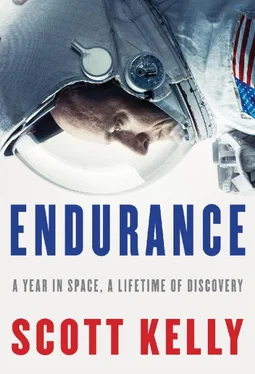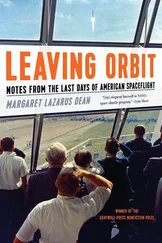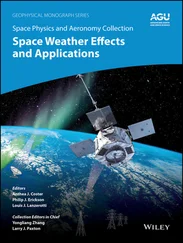—
THE DAY AFTER we arrive in Baikonur we have the first “fit check.” This is our opportunity to get inside the Soyuz capsule while it’s still in the hangar and not yet attached to the rocket that will launch us into space. In the cavernous hangar known as Building 254 we pull on our Sokol suits—always an awkward process. The only entrance into the suits is in the chest, so we have to slide our lower bodies into the chest hole, then struggle to fit our arms into the sleeves while blindly pulling the neck ring up over our heads. I often come away from this procedure with scratches on my scalp. Not having hair is a disadvantage here. The chest opening is then sealed through a disconcertingly low-tech process of gathering the edges of the fabric together and securing them with elastic bands. The first time I was introduced to this system I couldn’t believe those rubber bands were all that was meant to protect us from space. Once I got to the space station, I learned the Russians use the exact same rubber bands to seal their garbage bags in space. In one sense I find this comical; in another way I respect the efficiency of the Russian philosophy on technology. If it works, why change it?
The Sokol suit was designed as a rescue suit, which means that its only function is to save us in case of a fire or depressurization in the Soyuz. It’s different from the spacesuit I will wear during spacewalks later in my mission; that suit will be much sturdier and more functional, a little spaceship in its own right. The Sokol suit serves the same purpose as the orange NASA-designed pressure suit I used to wear to fly on the space shuttle. NASA introduced that suit only after the Challenger disaster of 1986; before that, shuttle astronauts wore simple cloth flight suits, as the Russians did before a depressurization accident killed three cosmonauts in 1971. Since then, cosmonauts (and any astronauts to join them in the Soyuz) have worn the Sokol suits. In a weird way, we are surrounded by the evidence of tragedies, too-late fixes that might have saved the astronauts and cosmonauts who took the same risks we are taking and lost.
Today is like a dress rehearsal: we suit up, perform leak checks, then get strapped into our custom-made seats, built from plaster molds taken of our bodies. This is not for our comfort, which is not a particularly high priority for the Russians, but for safety and to save space—no sense building more seat than is strictly necessary. The custom-molded seats will cradle our spines and absorb some of the impact on the hard return to Earth a year after we depart.
As much time as I have spent in the Soyuz simulators in Star City, I’m still amazed by how difficult it is to wedge myself and my pressure suit into my seat. Each time, I have a moment of doubt whether I’m going to fit. But then I do—just barely. If I were to sit up out of the seat liner, my head would smash against the wall. I wonder how my taller colleagues do it. Once we’re strapped in, we practice using the hardware, reaching out for buttons, reading data off screens, grabbing our checklists. We discuss what we might want to have customized for us, down to details such as where we want our timers (used for timing engine burns), where we want our pencils, and where we want the bits of Velcro that will allow us to put things “down” in space.
When we finish, we clamber back out of the hatch and look around the dusty hangar. The next Progress resupply vehicle is here; it looks very similar to the Soyuz, because the Russians never create two designs when one will do. In a few months, this Progress will deliver equipment, experiments, food, oxygen, and care packages to us on the ISS. After that, a Soyuz will launch in July carrying a new three-person crew. Somewhere in this hangar, the parts for the next Soyuz to fly after that are being assembled, and another one after that, and another one after that. The Russians have been launching the Soyuz since I was three years old.
The Soyuz spacecraft—Soyuz means “union,” as in “Soviet Union,” in Russian—is designed to maneuver in space, dock with the station, and keep human beings alive, but the rockets are the workhorses, humanity’s answer to the pull of Earth’s gravity. The rockets (which for some odd reason are also called Soyuz) are prepared for launch in an assembly and test facility across from the hangars known as site 112. Gennady, Misha, and I cross the street, pass the gathered Russian media, enter that enormous building, and stand in another cavernous, quiet room, this time regarding our rocket. Gunmetal gray, it lies on its side. Unlike the space shuttle or the colossal Apollo/Saturn that preceded it, the Soyuz spacecraft and rocket combination is assembled horizontally and rolled out to the launchpad in that position. Only when it reaches the launchpad, a couple of days before we launch, will it be set upright to vertical, pointing toward its destination. This is yet another example of how the Russians and Americans do things differently. In this case, the procedure is less ceremonial than the NASA way, with its stately, majestic rollouts of vertical launch vehicles balanced on an enormous crawler transporter.
At 162 feet long, this rocket, the Soyuz-FG, is noticeably smaller than the assembled space shuttle, but it’s still a daunting colossus, a building-size object that will, we hope, leave the ground, with us riding on top of it, at twenty-five times the speed of sound. Its navy gray sheet metal, adorned with low-tech rivets, is unbeautiful but somehow comforting in its utility. The Soyuz-FG is the grandchild of the Soviet R-7, the world’s first intercontinental ballistic missile. The R-7 was designed during the Cold War for launching nuclear weapons at American targets, and I can’t help remembering how as a child I was aware that New York City, and my suburb of West Orange, New Jersey, would certainly have been among the first targets to be instantly vaporized by a Soviet attack. Today, I’m standing inside their formerly secret facility, discussing with two Russians our plans to trust one another with our lives while riding to space on this converted weapon.
Gennady, Misha, and I all served in our militaries before being chosen to fly in space, and though it’s something we never talk about, we all know we could have been ordered to kill one another. Now we are taking part in the largest peaceful international collaboration in history. When people ask whether the space station is worth the expense, this is something I always point out. What is it worth to see two former bitter enemies transform weapons into transport for exploration and the pursuit of scientific knowledge? What is it worth to see former enemy nations turn their warriors into crewmates and lifelong friends? This is impossible to put a dollar figure on, but to me it’s one of the things that makes this project worth the expense, even worth risking our lives.
—
THE INTERNATIONAL SPACE STATION got its start in 1984, when President Reagan announced during his State of the Union address that NASA was designing a space station, Freedom, to be put in orbit within ten years. Resistance from Congress created years of cutbacks and reconfigurations, and Freedom was no closer to actually being built when, in 1993, President Clinton announced that the station would be merged with the Russian Federal Space Agency’s proposed space station Mir-2 . With the addition of space agencies representing Europe, Japan, and Canada, the international coalition came to include fifteen countries. It took more than one hundred launches to get the components into orbit and more than one hundred spacewalks to assemble them. The ISS is a remarkable achievement of technology and international cooperation. It has been inhabited nonstop since November 2, 2000; put another way, it has been more than fourteen years since all humans were on the Earth at once. It is by far the longest-inhabited structure in space and has been visited by more than two hundred people from sixteen nations. It’s the largest peacetime international project in history.
Читать дальше












